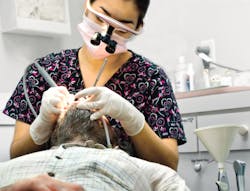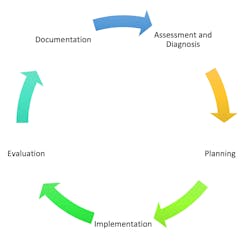The traits of a good dental hygiene employee
Dental hygienists are fortunate to have more opportunities than ever and are experiencing a developing importance in society, as the science and practice of dental hygiene continue to advance. Americans continue to value dental health, preventive health care, and dental hygiene visits. The evolution of decreased supervision requirements show a definite trend, which is affording dental hygienists more opportunities to work in more settings than ever before.
However, with the advent of many new dental hygiene programs, the job market for dental hygienists has become much more competitive. This makes it necessary for all dental hygienists to work to their full potential and to be valued as a high-performing employee. Being the best employee can help with job retention and potential recruitment.
Traits of effective employees
Understanding traits of effective employees is critical when trying to be the best dental hygienist (table 1).
A genuine care for outcomes at work includes such as caring for ourselves and others—including coworkers, supervisors, and patients. We genuinely care for others by showing our respectfulness in ways such as arriving to work on time. Our ability to work well with others is also a demonstration of caring. We will help others whether we are directly providing care or helping seat a patient for a coworker, because this helps everyone including the patient, the co-worker and the supervisor.
If we genuinely care for outcomes, we will come to work dress professionally, clean and polished. This may sound a bit old-fashioned, but I have never heard a complaint about a clean and professional health-care provider, but yet I have heard many complaints about the opposite. If we truly believe in the value of preventive health care, as dental hygienists, we need to model reinforce its value in our behaviors.
We need to give others a pass for a bad day and realize that every single human being has difficult circumstances we may be unaware of. This means we need to communicate with others frequently, and control our own behavior towards others as reaction to their behavior.
Another trait of an effective employee is to discuss issues with those involved and resist the urge to talk to other employees or vent to them. This often creates office drama and may initiate gossip.
Sometimes we may need to delay the discussion of an issue to diffuse heightened emotions. This should provide time to discuss issues calmly and the ability to also listen to others with a more attentive ear. Listening to others is one of the most effective methods of communication, because we can hear an issue from a perspective other than our own.
Additionally, make a conscious decision to have a positive attitude, which is consistently reported as an important trait to employers. I think all of us can think of times when our negative attitudes have had an unpleasant effect on an outcome at work. And I think most would agree that a positive attitude definitely helps make work more enjoyable and dealing with others in difficult situations much easier.
The ability to see opportunity in change is invaluable. Change, although many times uncomfortable, happens throughout work life. The ability to adapt to difficult change, such as in practice ownership, is easier for those employees who work well with others. Sometimes change can be positive, such as a difficult coworker moving on. In another instance, such as treating a patient with a negative attitude, it is important for the dental hygienist to stay positive and not let someone else’s attitude change his/her own attitude.
The process of care
Utilizing the dental hygiene process of care (figure 1) can be advantageous to excelling at work. The first process of care is the assessment phase.
Figure 1: The dental hygiene process of care
Assessment phase: This phase is particularly important for a good employee. A good employee wants to perform at the highest level possible at work and one way to ensure this is by self-assessment. We should always be honest when reflecting on our strengths and weaknesses and striving to perform better each day.
Many times our strengths can also be our weaknesses. For example, if a strength is popularity among our patients, how are we achieving this? Are we so worried about pleasing our patients that we are not able to have honest conversations about their continued plaque accumulation and the resulting consequences to their overall health?
Assessing one’s worth also means taking criticism or feedback and trying to use it to perform better. I think most of us realize that although feedback may be painful to hear at first, after a day or two (or maybe a little more) we can actually absorb it and make improvements based upon it. This trait also directly affects our ability to work with others. Very few managers enjoy supervising an employee who has difficulty working with others.
The ability to assess our weekday at the end of the end of each day, maybe on the drive or walk home, is a good time to review our actions of the day. Understanding how we behave and react at work is truly the first step to become a great employee!
Planning phase: Next up is the planning phase. In this phase, the dental hygienist should look at traits of effective employees and reflect on a plan to live these traits. How can we plan to have better clinical outcomes? We may need to develop a plan to update our clinical skills by attending a course or by advancing our degree.
So, how do we plan our reaction to negative behavior towards us, whether it comes from our supervivsor, patient or coworker? We can make the decision that if we feel insulted or disrespected, we have the ability to wait a day or two to plan our response, then develop a logical plan that helps all involved before reacting. Who knows, we may realize our need to apologize after reflecting on the situation. Apologies can be a strong communication characteristic in the workplace—when they are warranted and sincere.
We need to plan on how we can best come to work with a positive attitude. Positivity is very much within our control, because our attitude is our own and has nothing to do with others. We can make a decision to see things in a positive light and be the coworker who helps others remain positive. Develop a plan on when your attitude for the day will be determined. This could be walking or driving to work or the moment we wake up.
Implementation phase: During the implementation phase, which is the actual work experience, it is vital to remain competent in both dental hygiene skills and educational strategies. This means staying current with the standards of care that guide our practice. (1) This is accomplished by reading discipline-specific periodicals, attending courses and workshops, networking with other dental hygienists to discuss cases and issues (professional socialization), and/or enrolling in advanced degree programs. In essence, this is making sure that you are practicing at the top of your ability. This is what your patients deserve and this is what society expects from health-care providers. Not one of us would willingly go to an incompetent surgeon, just as our patients do not want to visit an incompetent dental hygienist.
Additionally, we need to put into place our planned strategies such as starting off the day with an attiude adjustment and positive outlook. We need to act on our ability, to not stir office gossip and displeasure. Also, we need to wait to react to a negative situation, so that we can control our behavior and hopefully improve the workplace instead of causing more of a disruption. Lastly, we need to remember to treat ourselves and others with respect.
Evaluation phase: Lastly is the evaluation phase, which is continually assessing our individual strengths and weaknesses and making changes as necessary. Also as important is the ability to adapt to change at work. This involves trying diligently to live without the fear of “what if” and analyzing the situation obsessively, which subsequently leads to more fear of “what if.”
Realize that change is a part of work and that highly functioning employees are those who embrace change and strive to find opportunities for positive outcomes in all situations. Continue the process of care to self-assess and develop plans to be the best dental hygienist possible.
Documentation phase: This phase should be inherent with workplace improvement and quality management. A strategy that would prove helpful to a dental hygiene employee would be to document achievements and positive changes that have been made so that when it is time for a performance review, possible raise discussion, or if there is a coaching session from a supervisor, the employee will be easily able to discuss the ways that he/she has strived to an effective, productive employee. This documentation should be positive and focus on the individual employee and not other workers or patients. Keep thank you notes from patients, coworkers, and/or community members from service initiatives to help showcase your accomplishments.
Conclusion
Employees who employers want to retain possess qualities or traits described above which, can all be summarized as a genuine, sincere care for their work. They want to provide quality care and they work well with others. By using the dental hygiene process of care, which would include self-assessment, dental hygienists can take steps to make their work environments more enjoyable.
Dental hygienists who want to improve their work place environments are those who generally will be retained or recruited. They are always looking for opportunities when the inevitable changes occur and their employers feel confident the days these dental hygienists are at work. These are the types of employees that others like to work with and make the workplace positive.
Reference
- American Dental Hygienists’ Association. Standards for Clinical Dental Hygiene Practice. https://www.adha.org/resources-docs/2016-Revised-Standards-for-Clinical-Dental-Hygiene-Practice.pdf. Published 2016. Accessed July 18, 2018
Christine Nathe, RDH, MS, is directorat the University of New Mexico division of dental hygiene, in Albuquerque, New Mexico. She is also the author of Dental Public Health Research, which is in its fourth edition with Pearson. She can be reached at [email protected] or (505) 272-8147.


